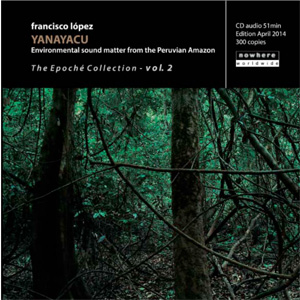The contextual information for most releases by the Spanish sound artist Francisco López are terse, to the extent that the track titles displayed on his otherwise blank sleeves are usually mere numbers (like last year’s ‘Untitled #308’ on Very Quiet Records which consisted of unedited unprocessed recordings from a Mexican rainforest and an Icelandic volcano). This is a deliberate strategy: to avoid planting seeds of expectation in its listeners ears, helping them overcome the instinct to identify and categorise the significance of his sources. The approach is inspired by the radical ideology of musique concrète, created by the French composer Pierre Schaeffer in the middle of the last century, which seeks to manipulate and combine recorded sounds for appreciation as sensual sound objects in their own right. Instead of curating and conserving an indexed archive of representational recordings, López builds sound objects for his audience to use as a means to gain respite from form, context and language, enabling a deep immersion in his largely unidentifiable sonic worlds. Performing live he distributes blindfolds among the audience or cancels light from the auditorium to help listeners fall into the arising phenomena (as opposed to phyla) he presents.
But these two latest releases depart from this stubborn, yet stupendous mystification, by having images and sleevenotes that specifically signpost where and when the sounds were from. Furthermore, each is accompanied by a philosophical quote (one from Baudrillard the other from Rancière) that call into question what is real in a world filled with the virtual realities of imagery and fiction, and, thereby, field recordings of the natural world.
Indeed, their academic sleeve design makes them look like the kind of CD you might pick up in a museum gift shop, to give tourists a memento of their brief sojourn in an exotic location, to be played as a backdrop to their next dinner party. But if that’s the expectation, the listener is going to be confounded as López’ releases, despite often being formed from field recordings, are somehow closer to the noise sculptures of artists such as Kevin Drumm or Russell Haswell, with their careful contrasts of detailed textures and depth of movement.
Hyper-Rainforest, an hour-long piece that originally premiered in New York in 2011 using "a specially designed ad hoc double-dome array of 82 speakers", is a vital collage of "non-transformed rainforest recordings" from 17 different countries. It starts and ends abruptly with the industrious buzz of bees, perhaps to suggest a continuum of sound life. From hereon, though, the range of sources has been carefully edited to keep the listener’s focus on the sounds themselves. For example, when the gushing roar of rain and wind on lush plant life is suddenly cut, the mysterious warbling that started when wet continues beyond the hard edit into a drier domain filled with intense chirruping. This type of manoeuvre strongly leads the ear to meditate on the incoming qualities, helping the brain to comprehend the piece almost like an orchestral work, replete with separate movements, motifs and codas.
In addition to the expert editing, the selection (or curation) of what is presented (and, therefore, omitted) is key to the powerful transformative effect Lòpez consistently achieves. Throughout Hyper-Rainforest it seems that almost all sound events have been selected for being remarkable, through their natural rhythmic, melodic or textural allure. Repetitive animal calls extend, far longer than a documentarian would dare, to hypnotic effect, while the aforementioned roar of air is often placed in the foreground (as opposed to clinically filtered out) as a foreboding elemental energy. This level of detail is often overwhelming, especially on a first listen, where subsequent rotations yield increasing quantities of stimulating aspects and correlations.
The editing style is much different on Yanayacu, a series of five works or "sound matter", as Lòpez likes to call it, from a river in the Peruvian Amazon. A gradual fade-in to a thriving environmental blend of bird and insect calls begins and concludes things this time, but it seems repetition of bloops, whistles and screeches are the dominant feature, such as the doomy vocals of what are presumably howler monkeys, or the weary whistling that could be human or animal. All taken together, over the semi-permanent high frequency backdrop of insects, they literally suggest a kingdom where adjustments to the balance of power are a natural part of the continuum.
But the greatest editorial sleight of hand is the sudden endings of all but Yanayacu‘s final track, each followed by several minutes of silence. Having been expertly seduced into following Lòpez into the forest and then listening hard to the thrills found there, this has the effect of being suddenly ejected from a dream into quotidian life, only the subtle, usually ignorable sounds of your living space suddenly flood in contrasting heavily with the more intense and exotic soundworld you had been inhabiting. This serves to highlight the profound meditative dislocation Lòpez’ releases afford – both artistic and therapeutic.
By increasingly using (and clearly stating he’s using) "non-transformed" environmental recordings, and now offering meaningful titles and sleevenotes to his traditionally oblique releases, it would seem that Francisco Lòpez is becoming less concerned with people’s abilities to "get" his outputs. After all, the showmanship is in the sounds themselves, where Hyper-Rainforest and Yanayacu are curated, edited and arranged to make immersion come easy, switching off the questing mind and turning on the subconscious to simply absorb sound as a sensuous artform.
<div class="fb-comments" data-href="http://thequietus.com/articles/15560-francisco-lpez-hyper-rainforest-yanayacu-review” data-width="550">


